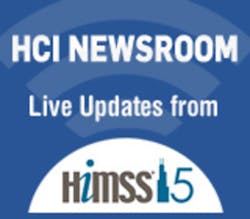At a well-attended April 15 HIMSS conference session in Chicago, leaders of the Argonaut Project gave an update on their progress to accelerate adoption of HL7’s FHIR (Fast Healthcare Interoperability Resources) standards framework, which leverages the latest web standards and application programming interfaces.
Joshua Mandel, M.D., lead architect for SMART on FHIR at Boston Children’s Hospital, offered up some quick demonstrations of the kinds of apps that are being developed, many of them visualization tools or tools that pull data from multiple sources to help patients and providers better understand conditions and see data in new ways. (You can view more than 20 in an apps gallery here. One example was developed by Geisinger offshoot xG Health. Its EnrG|Rheum app takes information from four data sources – the patient, the electronic health record, the nurse and the rheumatologist – and integrates this information into a series of actionable views and functions.
These apps are being demonstrated running inside Cerner or Athena EHRs or within Epic at Duke University, all without modification. (Currently the apps pull and consume the data from the EHRs on a read-only basis. Writing data to the EHRs involves a greater level of complexity.) Based on the level of commitment from so many players across the community, both vendors and providers, Mandel said he is “confident the Argonaut Project is going to succeed.” Argonaut is going to expand on the initial work on a broader scale by bringing together the right community, he said.
Argonaut is a key stakeholder in FHIR’s development, said Graham Grieve, the co-creator of FHIR, He said the basic idea is to allow people to exchange data, not just documents and narratives that are difficult to process. “Argonaut has members driving the process,” he said. “The first deliverables are complete. There are specifications you can go implement to provide access to data. Testing tools are available. We would like everyone to join us in testing.” Thirty organizations have already registered, he added.
Epic Systems President Carl Dvorak explained why the EHR giant is participating in Argonaut. “We see the need for keeping simple things simple,” he said. “There are some amazing things in that apps library, our internal developers are excited about it and we see a lot of support in academic center informatics programs.” He added, however, that while there are many easy things that can be harvested quickly, deeper challenges remain around creating not just a data model, but also an information model to go beyond cool visualizations to more difficult use cases such as clinical decision support. “We do see use cases that integrate other technologies such as communications devices,” Dvorak said.
When asked by an audience member whether FHIR developers were looking to replace the use of existing standards such as HL7, version 2, Mandel said existing standards that are used widely are not going to be the first target. “Providers are going to invest where they can solve new problems,” he said. Then perhaps slowly over time they will focus on other issues.
HL7 President Charles Jaffe, M.D., Ph.D., said FHIR developers work well with other HL7 work groups on the best possible retention of those elements with a focus on where FHIR can augment them.
John Halamka, M.D., CIO of the Beth Israel Deaconess Medical Center in Boston and a member of the Argonaut team, agreed, saying the standards family is working well together. “It is not a competition,” he said.
Jaffe urged audience members to become one of the implementation sites and contribute to the evolution. “We have ambitious program for further development. We need feedback into things that have been done well and things that need to be enhanced or changed.”


